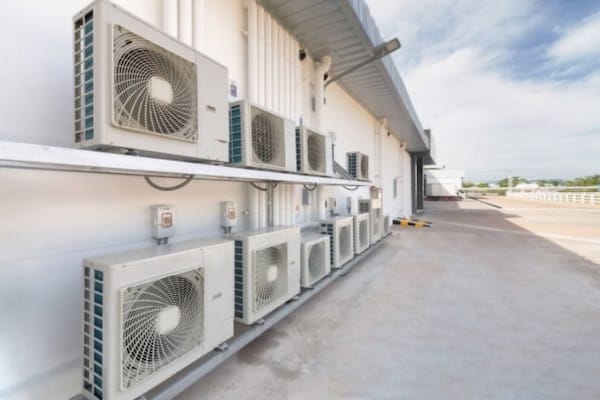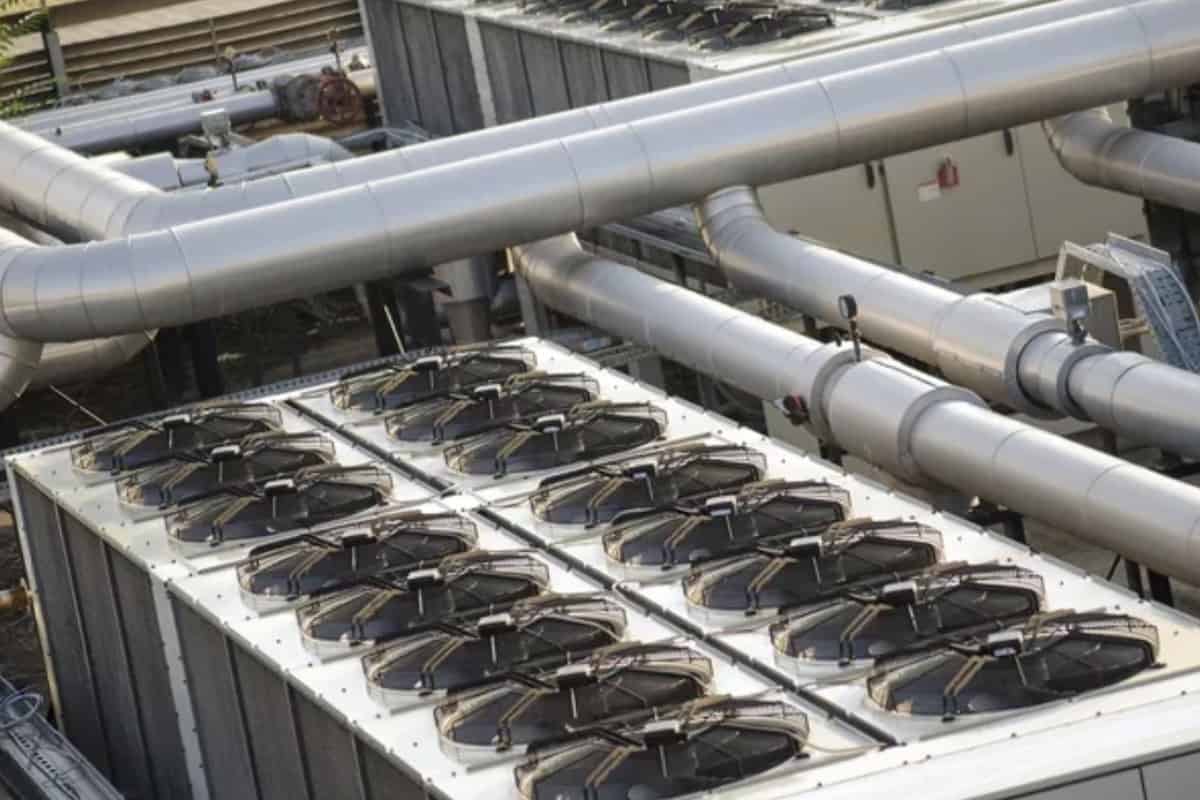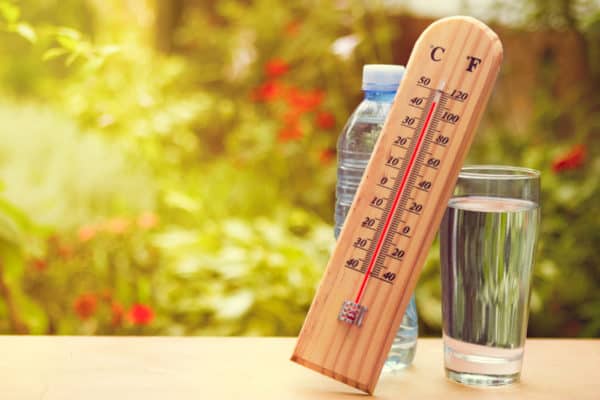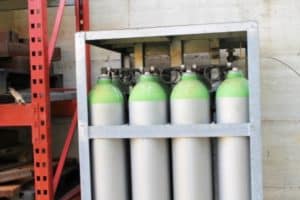3 Types of Air Conditioning Systems in Commercial Buildings
In commercial buildings, there are mainly 3 types of air conditioning systems. Each air conditioning system has its own unique advantages and it suits certain applications. So, what are the 3 types of air conditioning systems in commercial buildings?
The 3 types of air conditioning systems in commercial buildings are: 1) chilled water system, 2) VRF system and 3) split system. Among them, the chilled water system is the most popular air conditioning system in commercial buildings due to its higher efficiency.
Although high efficiency is desirable, the chilled water system can’t be used in every commercial building and there are some good reasons to why.
1. Chilled Water System
Chilled water system is the largest air conditioning system in terms of total cooling capacity. Besides, chilled water system also occupy more spaces than other air conditioning systems.

Generally, chilled water system is preferred when the total cooling capacity exceeds 600 RT (refrigeration ton). However, it is not always the case. The system has disadvantages that other air conditioning systems can make up.
How the Chilled Water System Works?
Chilled water system uses ordinary water as the medium of heat transfer. Usually, it uses more than one water-cooled chillers to cool the water down to around 6.7°C (44°F). Then, multiple chilled water pumps will circulate the chilled water through many air handlers in the building for cooling.
At each air handler, the chilled water flows through the cooling coil of the air handler which in turn cools the cooling coil. Then, the air handler circulates indoor air through the cooling coil and supplies cold air to the room.

The amount of chilled water allowed to be flowing through the cooling coil of an air handler is controlled by a valve that is controlled by a thermostat. When the room is sufficiently cooled, the thermostat will trigger a signal for the valve to close and stop the flow of chilled water.
With the chilled water valve, the capacity of the air handler of the chilled water system can be controlled.
Once the chilled water absorbed the heat at the air handlers, its temperature usually raises to around 12.2°C (54°F) and it’ll return back to the water-cooled chillers. The water-cooled chillers, the chilled water pumps and the air handlers altogether form the chilled water loop.
On the other hand, several condenser water pumps circulate ordinary water from a few cooling towers to the water-cooled chillers. Cooling towers spray condenser water onto their fins and circulate the ambient air through their fins to cool down the water.

At each water-cooled chiller, the condenser water flows through the shell-and-tube heat exchanger of the water-cooled chiller where the refrigerant of the water-cooled chiller is also flowing through in a separate compartment to absorb the heat from the refrigerant.
When the refrigerant of the water-cooled chiller is cooled by the condenser water, it cycles through an expansion valve where it is expanded and further cooled down to around 6°C (42.8°F). Then, the cold refrigerant flows through another shell-and-tube heat exchanger where ordinary water is also flowing through in a separate compartment to produce the chilled water.
The water-cooled chillers, the condenser water pumps and the cooling towers altogether form the condenser water loop. The refrigerant, the expansion valve and the shell-and-tube heat exchangers as well as the compressor, which I’ve not mentioned, altogether form the refrigeration cycle within the water-cooled chillers.
Advantages of the Chilled Water System
The primary advantage of the chilled water system is undoubtedly high energy efficiency. In context, a single water-cooled chiller is almost twice as energy-efficient as a split unit.
The cooling demand in large commercial buildings is high. If the split system is used for a 600 RT application, about 600 units of 1 ton air conditioner is needed versus only 3 units of 200 RT water-cooled chiller if it was the chilled water system instead.
Hence, the overall operating cost and maintenance cost is lower for the chilled water system.
However, because the chilled water system is a centralized cooling system, it can’t handle cooling demand fluctuation very well. For example, the chilled water system may not perform as good as the split system in hotels because hotels have guests coming in and out on a daily basis thereby moving the cooling demand on a greater scale.
“Chilled water system performs poorly when cooling demand is low.”
The water-cooled chillers in the chilled water system operate using large compressors. Large compressors are unable to run slowly to reduce their cooling capacity in order to meet the low cooling demand. Hence, oversupplying of chilled water will happen when the cooling demand drops beyond the lowest capacity of the water-cooled chillers.
Therefore, the water-cooled chillers consume power to produce unnecessary amount of chilled water thereby wasting energy and causing high electricity bills.
Nevertheless, the chilled water system can change its chiller type from water-cooled chillers to running with air-cooled chillers. Air-cooled chillers don’t require cooling towers and condenser water pumps but they are less efficient than water-cooled chillers.
Air-cooled chillers use smaller compressors than water-cooled chillers. So, when the cooling demand is low, they can reduce their cooling capacity sufficiently to prevent the oversupplying of chilled water which in turn causing the high electricity bills.
So, water-cooled chiller chilled water system is more suitable for stable cooling demand buildings such as shopping malls and hospitals while air-cooled chiller chilled water system is more suitable for cooling demand fluctuating buildings such as hotels and offices.
Check out related topics surrounding the chilled water system from my previous blog posts.
In the meantime, I would like to inform you that you can learn quicker by getting my HVAC Begin (eBook) if you’re a beginner. But, if you have a year or two of experience, then I would suggest you consider my HVAC Basics (eBook). Nonetheless, I encourage you enroll in my HVAC Beginner Course: 10 Days to Become Competent in HVAC if you want to equipped yourself with a complete set of basic HVAC skills.
HVAC Beginner Course
Learn the most basics and foundational HVAC skills including cooling capacity calculation, equipment selection, duct sizing, pipe sizing, exhaust fan sizing, controls, electrical and more.
2. VRF System
VRF system or variable refrigerant flow system is a relatively new air conditioning system that uses one condensing unit and sophisticated controls to distribute optimized amount of refrigerant to each connected evaporating unit for cooling.

The range of the cooling capacity of a single VRF system can start from as low as 11 kW (3 RT) up to as high as 168 kW (47.7 RT). The number of VRF systems in a building is unlimited but restricted by the space, the cost and the practicality of the air conditioning system.
How the VRF System Works?
VRF system fundamentally works the same as the split system. It uses the refrigeration cycle which includes the 4 major components; a) compressor, b) condenser, c) evaporator and d) expansion valve to perform cooling. However, the compressor and the condenser are the two components that make the VRF system different from the split system.
Traditionally, split system has one condensing unit and one evaporating unit in which we usually called them the indoor unit and the outdoor unit, respectively.
However, for VRF system, one outdoor unit can be connected up to 64 indoor units with each indoor unit can be of different types such as wall-mounted, ceiling cassette and ceiling ducted. Hence, the VRF system offers a wide range of variety and flexibility for design.
One of the most important things in the VRF system is the refrigerant pipe joint or refnet joints. Refnet joints are pipe fittings for the refrigerant pipe of the VRF system. They serve to distribute the refrigerant in the VRF system.
Unlike multi-split system, VRF system doesn’t have a bunch of copper tubes running around connecting air conditioners. Instead, VRF system starts with a set of copper tubes at the farthest air conditioner. Then, the set of copper tubes join with another set of copper tubes from another air conditioner via a refnet joint and form a new set of copper tubes. Then, the new set of copper tubes join with another set of copper tubes from another air conditioner via another refnet joint, and so and forth.
So, a VRF system can have 3, 7, 10 or even 30 refnet joints depending on the total cooling capacity and the number of indoor units in the system.
The refnet joint used in the VRF system is nothing but an engineered piece of copper tube branch with their sizes and bend angles designed to distribute refrigerant based on the design of the VRF system. Hence, refnet joints require brazing and insulation just like the other copper tubes in the VRF system.
Learn more about the working principle of VRF system from my previous blog post.
Advantages of the VRF System
The main advantage offered by the VRF system is the ability to run the building’s air conditioning system independently in different thermal zones, rooms and floors.
A 30-storey building can have 30 VRF systems with each system serving one floor. If one of the VRF systems is malfunctions, the other 29 floors are still having air conditioning. Whereas if the building is fitted with a chilled water system, a malfunction may cause the entire building to lose air conditioning.
Furthermore, VRF system is excellent in handling low cooling demand. While it is impossible for the chilled water system to provide air conditioning when there is only one room in the entire building is needing the air conditioning, the VRF system can effortlessly provide air conditioning and simultaneously run at the highest efficiency.

However, the main downside of the VRF system is the high potential and high impact of refrigerant leaks.
Refrigerant leaks in the VRF system are extremely difficult and tedious to fix. The copper tubes in the VRF system can stretch up to 1000 meters long from the farthest indoor unit to the nearest outdoor unit and the leak can be anywhere in between. Most of the time, the repair is done by means of installing a new set of copper tubes.
So, VRF system is not suitable for tall buildings and wide buildings where it needs to stretch its copper tubes for impractically long distances such as shopping malls, factories and warehouses.
Nevertheless, VRF system is better than split system in terms of energy efficiency and thus, it is widely used in certain sizes of hotels, retail stores and offices.
3. Split System
Split system is undoubtedly the most popular type of air conditioning system for residential applications. When it comes to commercial applications, the split system usually serves as a backup or provides cooling for untypical rooms.

Split system in general has two types; a) single-split and b) multi-split. Single-split system is the one I mentioned earlier which has one indoor unit and one outdoor unit. On the other hand, the multi-split system is similar to VRF system which has only one outdoor unit but can have multiple indoor units. However, in the case of the multi-split system, it can only have only up to 5 indoor units.
Multi-Split System
Multi-split system does not work like the VRF system. While the VRF system has refrigerant flow control, the multi-split system doesn’t and it acts more like a multiple combined single-split system.
The amount of refrigerant copper tubes used in the multi-split system is pretty much the same as the single-split system. The only difference between the multi-split and the single-split system is the outdoor unit size and the additional controls in the multi-split system.
Multi-split system take advantage of cooling capacity sharing. The cooling capacity of the outdoor unit of the multi-split system is always slightly less than the sum of the cooling capacity of its indoor unit because, with the multi-split system, the user is expected to not be using all indoor units concurrently.
Hence, the design of the multi-split system in buildings is critical to the success of taking advantage of the system. Otherwise, the multi-split system is nothing more than a space-saving air conditioning system.
Single-Split System
Meanwhile, the single-split system provides the greatest reliability of all. It is an independent system, much more independent than both the multi-split and the VRF system.
One-to-one configuration means that the single-split system only affects itself when there is a malfunction. Furthermore, any repair or maintenance works of a single-split system don’t affect others.

Server rooms, control rooms and other essential-service rooms usually use the single-split system alone or install the single-split system as a backup while the primary air conditioning system is the chilled water system.
Learn tons of interesting facts and knowledge about the split system from my previous blogs.
Comparison of the 3 Types of Air Conditioning Systems
As a summary, the below table is what I would rate each air conditioning system using a 5-star rating scale for its wellness in each category listed in the table:
| Chilled Water System | VRF System | Split System | |
|---|---|---|---|
| Rating | Rating | Rating | |
| Commercial Applications | ★★★★★ | ★★★☆☆ | ★☆☆☆☆ |
| Cooling Capacity | ★★★★★ | ★★☆☆☆ | ★☆☆☆☆ |
| Low Load Performance | ★☆☆☆☆ | ★★★★★ | ★★★★★ |
| Energy Efficiency | ★★★★★ | ★★★☆☆ | ★☆☆☆☆ |
| Design Flexibility | ★★☆☆☆ | ★★★★★ | ★☆☆☆☆ |
| Space Requirement | ★☆☆☆☆ | ★★★★☆ | ★★★☆☆ |
| Installation | ★☆☆☆☆ | ★★★☆☆ | ★★★★★ |
| Maintenance | ★★☆☆☆ | ★★★☆☆ | ★★★☆☆ |
| Cost | ★☆☆☆☆ | ★★★☆☆ | ★★★★★ |
Conclusion
In short, not a single air conditioning system can be the best air conditioning system of all. Each and every air conditioning system has its own unique advantages and thus, applications. Building owners, design engineers and contractors must fully understand the air conditioning system so that the projects and buildings they are going to construct will be fitted with the best-suited air conditioning system.
Lastly, consider my HVAC Begin (eBook) if you’re a beginner and you want to have a foundational knowledge in HVAC. But, if you have a year or two of experience, then I would suggest you consider my HVAC Basics (eBook). Nonetheless, I encourage you enroll in my HVAC Beginner Course: 10 Days to Become Competent in HVAC if you want to equipped yourself with a complete set of basic HVAC skills.
HVAC Beginner Course
Learn the most basics and foundational HVAC skills including cooling capacity calculation, equipment selection, duct sizing, pipe sizing, exhaust fan sizing, controls, electrical and more.
If you have anything to add (or ask) about this topic, leave a comment down below!









